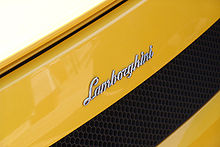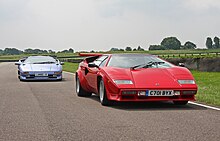 |
| The Lamborghini wordmark, as displayed on the back of its cars. |
The world of bullfighting is a key part of Lamborghini's identity. In 1962, Ferruccio Lamborghini visited the Seville ranch of Don Eduardo Miura, a renowned breeder of Spanish fighting bulls. Lamborghini, a Taurus himself, was so impressed by the majestic Miura animals that he decided to adopt a raging bull as the emblem for the automaker he would open shortly.
After producing two cars with alphanumeric designations, Lamborghini once again turned to the bull breeder for inspiration. Don Eduardo was filled with pride when he learned that Ferruccio had named a car for his family and their line of bulls; the fourth Miura to be produced was unveiled to him at his ranch in Seville.
The automaker would continue to draw upon the bullfighting connection in future years. The Islero was named for the Miura bull that killed the famed bullfighter Manolete in 1947. Espada is the Spanish word for sword, sometimes used to refer to the bullfighter himself. The Jarama's name carried a special double meaning; intended to refer only to the historic bullfighting region in Spain, Ferruccio was concerned about confusion with the also historic Jarama motor racing track.
 |
| The Diablo (background) was named for a legendary bull, while the Countach (foreground) broke from the bullfighting tradition. |
After christening the Urraco after a bull breed, in 1974, Lamborghini broke from tradition, naming the Countach not for a bull, but for countach!, an exclamation of astonishment used by Piedmontese men upon sighting a beautiful woman. Legend has it that stylist Nuccio Bertone uttered the word in surprise when he first laid eyes on the Countach prototype, "Project 112". The LM002 sport utility vehicle and the Silhouette were other exceptions to the tradition.
The Jalpa of 1982 was named for a bull breed; Diablo, for the Duke of Veragua's ferocious bull famous for fighting an epic battle against "El Chicorro" in Madrid in 1869; Murciélago, the legendary bull whose life was spared by "El Lagartijo" for his performance in 1879; Gallardo, named for one of the five ancestral castes of the Spanish fighting bull breed; and Reventón, the bull that defeated young Mexican torero Félix Guzmán in 1943. The Estoque concept of 2008 was named for the estoc, the sword traditionally used by matadors during bullfights.
0 nhận xét:
Post a Comment